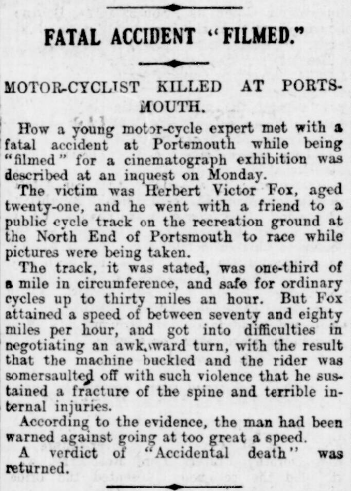Herbert Victor Fox (lost footage of fatal motorcycle accident; 1914)
On 25th April 1914, Herbert Victor Fox competed in a motorcycle race held at the North End Recreation Ground in Portsmouth. On the second lap, Fox rode too fast on a tight bend, became unseated from his J.A.P. bike and was dragged helplessly across the circuit and into nearby railings. The impact inflicted a pelvis haemorrhage that Fox passed away from nearly six hours later. It is known that footage of the fatal accident was recorded on camera.
Background
Herbert Victor Fox was the son of naval architect Arthur George Fox. Aged 21, he had accumulated at least four years of motorcycling experience.[1] Fox's main motorcycle was an 8hp J.A.P.; the bike would have been at least six years old as J.A.P. moved exclusively towards engine development by 1908.[2][1] Aside from riding motorcycles, Fox was cited as being an expert in manufacturing and maintaining them.[3][4][1] He frequently travelled with his friend and Army pupil Cecil William Allen to the North End Recreation Ground in Portsmouth.[1][4] Opened in June 1892, the North End Recreation Ground consisted of 24 acres of land and was designed to accommodate cricket and cycling.[5]
In the ground was a 1/3 mile cycling track; in the enquiry regarding Fox's death, then-Superintendent of the Parks and Open Spaces Harry Edmunds described the track as D-shaped.[1][4] At the straight's east exit was a bend slated to contain 2 feet and 9 inches of bank. Though the track lacked an official speed limit, Edmunds had advised riders not to exceed 30 mph to avoid an accident on the sharp bend.[1][3] He stated the track was intended exclusively for bicycles and not designed for the higher speeds motorcycles could attain. Ten days before his fatal accident, Fox was warned by Edmunds that he was exceeding track limits by about 10 mph. However, Edmunds had no official power to enforce safety or to prevent dangerous racing from commencing.[1]
The Accident
Fox and Allen were present at the North End Recreation Ground to feature in a two-mile handicap exhibition race. One of the main incentives to compete was that a film company planned to record highlights for an upcoming cinematograph show.[1][3][4] Before the race, Fox was pulled aside by motor engineer Thompson Thompson. Thompson deemed Fox as a very competent motorcyclist but one who regularly liked to reach his J.A.P.'s top speed of 80 mph. He reckoned the track was only safe for 2¾hp motorcycles with a top speed below 40 mph. Hence, like Edmunds beforehand, Thompson warned Fox that he needed to slow down.[1] He also reminded the young rider that the race was merely an exhibition intended for filming purposes.[1][3][4] Fox responded "That will be all right, Mr. Thompson; I'll look after that". Fox began the event 40 yards ahead of Allen. He seemingly took Thompson's advice to heart, riding at around 30-35 mph on lap 1.[1]
But a lap later, Fox returned to old habits, accelerating at least 45 mph down the straight.[1] Edmunds and Thompson's fears soon became reality. When Fox took the bend, his J.A.P.'s left footrest collided with the tarmac. The impact caused Fox to become unseated, with his hands still gripping the handlebars. One of his feet was also trapped in the bike. Helpless, Fox was dragged off the circuit at high speed, before the bike's rear tyre crashed into nearby railings. This resulted in Fox being thrown free and coming to rest nearby his written-off bike.[1][3][4] Though Fox was still conscious, he was in a terrible state. Aside from shock, Fox fractured his lumbar spine and was suffering from internal bleeding.[1][4] He was swiftly administered first aid by Police Constables Budden, Thompson and Thatcher and fellow cyclist Redding. He and PC Budden agreed that he should have heeded Thompson's warning. Fox was subsequently taken to a local hospital, where he was attended to by Dr. Edward Brunton.[1]
According to Dr. Brunton, Fox was "collapsed pale", suffered from shock and was reporting severe pain in the lower back. Worse still, doctors were unable to find the source of the haemorrhage, which a post-mortem examination determined originated in the pelvis. Because of this, Fox's state worsened over the next five hours.[1] 45 minutes later, Fox passed away.[1][3][4] Based on the post-mortem examination and eyewitness accounts, Sir Thos Bramsdon delivered an accidental death verdict, deeming that Fox was riding excessively fast and without due care.[1][3] He nevertheless defended racing and suggested that a new, larger track should be built at the North End Recreation Ground. He also anticipated the track's owners would make sufficient changes to prevent future accidents.[1] Because of the extensive newspaper coverage of Fox's fatal accident from April to May 1914, Motorsport Memorial was able to add a page to its website dedicated to the young rider.[4]
Availability
Based on the newspaper articles available on The British Newspaper Archive, most notably the 27th April 1914 issue of Portsmouth Evening News that delivered the full inquiry into Fox's death,[1] it is believed the rider's fatal accident was captured on film.[6][3][4] It is unclear whether the crash or footage captured prior to it was ultimately used in the unidentified film company's picture show. The crash often commonly cited as the "first recorded motor racing accident" was taken by British Pathé in September 1919. It depicted Louis-Joseph Chevrolet being involved in a non-fatal incident in his Frontenac while competing at the Coney Island Raceway.[7][8] This adds credence to the likelihood that footage of Fox's fatal accident is missing, as it predated Chevrolet's incident by five years. Early death footage has also garnered infamy, particularly that of Franz Karl Reichelt and Emily Davison,[9] meaning Fox would have received similar attention had the clips survived. The recording is most likely among 80-90% of pre-1928 films that are deemed forever lost.[10][11] No photos of the event or Fox's crash are known to exist.
See Also
Fatal Filming Accidents
- Across the Border (lost silent western film and footage of fatal filming accident; 1914)
- Albert Brighton (lost footage of fatal filming accident; 1911)
- Banned Film Festival (partially found film festival movies; date unknown)
- The Crow (lost Brandon Lee death footage from dark fantasy superhero film; 1993)
- Drowning Scene at Rockaway (lost film of alleged legitimate drowning accident; 1897)
- Elisabeth Imre (lost footage of fatal filming accident/possible suicide; 1913)
- M. Leclinche and Dionys Kovalik (lost footage of fatal filming accidents; 1912)
- M. Otreps (lost footage of fatal filming accident; 1909)
- Midnight Rider (partially found unfinished biographical film based on band; 2013-2014)
- Mitr Chaibancha (lost death footage of Thai actor; 1970)
- Noah's Ark (partially lost film based on Bible story; 1928)
- The Skywayman (lost action drama film and death footage of stunt pilots; 1920)
- Underground (lost ITV teleplay broadcast; 1958)
- Wilhelm Zeitz (lost footage of fatal filming accident; 1907)
Fatal Motor Racing Accidents
- 1955 24 Hours of Le Mans (partially found footage of World Sports Car Championship race; 1955)
- Angelo Orsi's photos of Ayrton Senna (lost photos of Formula One driver post-crash; 1994)
- Anthoine Hubert and Juan Manuel Correa (partially found FOM footage of fatal Formula 2 crash; 2019)
- Ayrton Senna (partially lost on-board video of fatal Formula One crash; 1994)
- Dan Wheldon (partially lost onboard footage of fatal IndyCar crash; 2011)
- Elmer Trett (lost footage of fatal Top Fuel Motorcycle drag racing crash; 1996)
- Formula One (partially found footage of Grand Prix races featuring fatal and/or serious accidents; 1958-1978)
- IndyCar (partially found footage of IndyCar races featuring fatal and/or serious accidents; 1916-1996)
- Jason Leffler (lost footage of fatal 410 Sprint Car accident; 2013)
- Jules Bianchi (lost FOM footage of fatal Formula One crash; 2014)
- María De Villota (lost footage of fatal Formula One crash; 2012)
- NASCAR (partially found footage of NASCAR races featuring fatal and/or serious accidents; 1964-2002)
- Neil Shanahan (lost footage of fatal British Formula Ford Zetec Championship crash; 1999)
- Paul Warwick (lost footage of fatal British F3000 crash; 1991)
- Sébastien Enjolras (lost footage of fatal 24 Hours of Le Mans pre-qualifying accident; 1997)
- Tony Renna (lost security camera footage of fatal IndyCar test session crash; 2003)
References
- ↑ 1.00 1.01 1.02 1.03 1.04 1.05 1.06 1.07 1.08 1.09 1.10 1.11 1.12 1.13 1.14 1.15 1.16 1.17 1.18 1.19 27th April 1914 issue of Portsmouth Evening News reporting on the full verdict of Fox's accident (found on The British Newspaper Archive, p.g. 5). Retrieved 20th Oct '24
- ↑ Sheldon's Emu summarising the history of J.A.P.. Retrieved 20th Oct '24
- ↑ 3.0 3.1 3.2 3.3 3.4 3.5 3.6 3.7 28th April 1914 issue of Northern Daily Telegraph reporting on the incident and that it was filmed (found on The British Newspaper Archive, p.g. 8). Retrieved 20th Oct '24
- ↑ 4.0 4.1 4.2 4.3 4.4 4.5 4.6 4.7 4.8 4.9 Motorsport Memorial page for Herbert Victor Fox. Retrieved 20th Oct '24
- ↑ 9th June 1892 issue of The Surveyor reporting on the opening of the North End Recreation Ground (p.g. 327). Retrieved 20th Oct '24
- ↑ 1st May 1914 issue of Loftus Advertiser reporting that Fox's crash was filmed (found on The British Newspaper Archive, p.g. 3). Retrieved 20th Oct '24
- ↑ British Pathé's footage of Louis-Joseph Chevrolet's crash. Retrieved 20th Oct '24
- ↑ Bang Shift summarising Louis-Joseph Chevrolet's crash, commonly cited as the first filmed racing accident. Retrieved 20th Oct '24
- ↑ Ben Beck's Website summarising early recorded death footage, including that of Franz Karl Reichelt and Emily Davison. Retrieved 20th Oct '24
- ↑ Film Foundation claiming that roughly 90% of pre-1929 films are forever lost. Retrieved 20th Oct '24
- ↑ Deutsche Kinemathek stating roughly 80-90% of silent films are permanently missing. Retrieved 20th Oct '24

